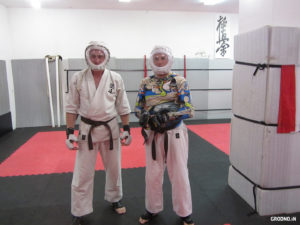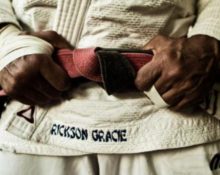Kudo wrestling stands out among martial arts for its fierce battles. This sport combined elements of boxing, karate, judo, taking from each quite tough contact techniques and throws, including choking and painful, and even “finishing off” the enemy. What kind of martial arts is this and how to determine the level of skill of an athlete by the color of the belt, read about it further.
Conditions for certification in kudo
 This type of martial art was created in 1981 by the Japanese philosopher and athlete Azuma Takashi, who initially “comprehended” kyokushin karate and judo. Kudo is closest to the conditions of a real battle and is positioned as a hyper-real fight, its popularity in the world is growing year by year.
This type of martial art was created in 1981 by the Japanese philosopher and athlete Azuma Takashi, who initially “comprehended” kyokushin karate and judo. Kudo is closest to the conditions of a real battle and is positioned as a hyper-real fight, its popularity in the world is growing year by year.
Kudo has been known in Russia since the early 90s, but it was declared an independent sport in the country only in 2017. Much of the credit for this goes to the athletes who promote martial art: since 2005, the Russian national kudo team has been deservedly considered a world leader.
Important! Over the past 14 years, almost all gold medals at the world championships have gone to Russians, and in 2009, kudo players from Russia won all the gold at the world championship.
Any athlete strives to win competitions and achieve a certain height in the comprehension of martial art. In Kudo there is a sports certification, held twice a year - in spring and autumn, and also in summer, after the end of training camps. It includes testing knowledge and skills, mastery of certain techniques:
- punches and kicks;
- shocks in motion;
- two-beat compositions;
- sparring with partners;
- checking the work on the paws;
- throws;
- wrestling on the ground;
- barbell bench press;
- general physical fitness exercises;
- stretching;
- conducting fights with and without a helmet.
Successful completion of all stages of assessment means that the techniques and skills demonstrated are equivalent to official promotion to the next level. Receiving a new belt is a confirmation of the maximum technical skills and abilities acquired during training.
Important! The darker the color of the belt an athlete wants to get, the more requirements he must meet. Children from 7 to 9 years old are certified without participating in competitions.
Requirements for athletes
To avoid injuries, athletes wear special equipment for fights. It includes many additional elements that protect individual areas of the body:
 helmet;
helmet;- boxing gloves;
- mouth guard;
- boxing bandage;
- cue ball;
- kimono;
- shin protection;
- groin protection.
Fights can be carried out with or without a helmet made of impact-resistant plastic; this is discussed before the competition in accordance with the rules. Children should be additionally protected by a bib.
To conduct fights, participants are divided into categories, which, in addition to age, take into account the sum of the athlete’s height and weight. The fight lasts 3 minutes. During this time, opponents strive to deliver as many blows as possible with their hands, feet, elbows, knees, and perform the maximum number of throws and painful holds.
Important! In kudo, there is a ban on hitting the groin and back area, the back of the head, and it is also not allowed to finish off a defeated opponent in a prone position to the head.
Kudo belts in order
In Eastern martial arts, there is a belt system that indicates the degree of mastery of the martial art. Kudo is no exception in this sense, but The color of the belt does not match here and reading the information about the skill level is different from other sports. There are student and workshop belts in the system.
Student
 Belts are counted from 10 to 1 kyu in reverse order. A higher level in apprenticeship is indicated by a lower kyu number. The belt dimensions are a standard length of 2 meters and a width of 4 cm. There is a more accurate formula for determining the length: 110 cm + double waist circumference. The emblem of the sports school is sewn on one end, and 3 cm from it a strip of black (or other color) fabric 5 mm wide is sewn, indicating the level of apprenticeship.
Belts are counted from 10 to 1 kyu in reverse order. A higher level in apprenticeship is indicated by a lower kyu number. The belt dimensions are a standard length of 2 meters and a width of 4 cm. There is a more accurate formula for determining the length: 110 cm + double waist circumference. The emblem of the sports school is sewn on one end, and 3 cm from it a strip of black (or other color) fabric 5 mm wide is sewn, indicating the level of apprenticeship.
The initial level, zero, when a person who has come to the sport has not yet learned anything special, is indicated by the color white. The white belt is marked only with a special emblem indicating that it belongs to a type of martial art..
Students in kudo are divided into the following ranks:
- gakusei – student;
- senpai - senior student.
It is believed that You can get 5 kyu only by devoting at least 5 years to studying the basics of martial art. After each certification, Gakusei changes the color of his belt or adds one stripe:
- 10, 9 kyu – purple belt;
- 8, 7 kyu – blue;
- 6, 5 kyu – yellow;
- 4, 3 kyu – green;
- 2, 1 kyu – brown.
In each even-numbered kyu, one stripe is sewn onto the belt, in an odd-numbered kyu, two. Its color is either black or matches the shade of the next kyu. Sometimes the purple color is replaced by white, but also with one or two stripes.
Workshops
 Next after 1st kyu in qualification is 1st dan. Now the count goes from 1st dan to 10th. All masters wear black belts with gold stripes. The dimensions of the workshop attributes are completely identical to the student ones, except that each new level of skill is indicated by an additional gold stripe up to and including the 4th dan. The next 6th dan requires one wide gold stripe. In the 7th, one narrow is added to the wide one, in the 8th - another one, and so on up to the 9th dan inclusive. The highest, 10th dan, is indicated by two wide stripes joined together.
Next after 1st kyu in qualification is 1st dan. Now the count goes from 1st dan to 10th. All masters wear black belts with gold stripes. The dimensions of the workshop attributes are completely identical to the student ones, except that each new level of skill is indicated by an additional gold stripe up to and including the 4th dan. The next 6th dan requires one wide gold stripe. In the 7th, one narrow is added to the wide one, in the 8th - another one, and so on up to the 9th dan inclusive. The highest, 10th dan, is indicated by two wide stripes joined together.
On each black belt, made in a special workshop in Japan, next to the emblem there is the name of the school, the surname and name of the owner, embroidered with hieroglyphs. Such insignia among masters in this type of martial art are sewn by order of the Grand Master Azuma Takashi himself, holder of the 9th dan. In the Russian Federation, the highest level of skill was achieved by the President of the Kudo Federation, Roman Anashkin, who became the first athlete of non-Japanese origin certified for the honorary title of 6th Dan master.


 helmet;
helmet; 0
0





